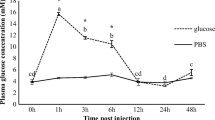Summary
-
1.
The wood frog,Rana sylvatica, can survice extracellular freezing during overwintering. Under laboratory conditions freezing occurred at about −2°C and animals survived several days at −6°C.
-
2.
Frogs accumulated glucose as a cryoprotectant; glycerol, sorbitol and other sugars were not produced. Average levels of glucose in frozen antimals were 185±40 μmol/ml in blood and 387.8±44.8, 198.3±27.3, 120.8±14.1 and 26.5±2.7 μmol/g wet weight in liver, heart, kidney and leg muscle, respectively.
-
3.
Two methods of cold acclimation, 11 weeks at 3°C or a 1°C per day decrease in temperature from 23°C to 0°C, failed to stimulate an anticipatory rise in glucose levels. Only direct exposure to subzero temperature between 0°C and −2°C stimulated synthesis.
-
4.
Glucose synthesis appeared to be confined to liver with glucose distributed through the blood to other tissues. Freezing exposure resulted in a decrease in liver glycogen content of over 700 μmol/g wet weight while glycogen content of other tissues was not affected.
-
5.
Activities of 17 enzymes in liver and leg muscle were monitored in control and freezing exposed frogs. Freezing exposure increased liver phosphorylase activity by 520% from 3 to 18.6 units/g wet weight and increased phosphorylasea content from 37 to 80%. Freezing also elevated glucose-6-phosphatase activity by 140%. Activities of most other enzymes in liver increased by 30–90% with freezing exposure. Activities of phosphorylase and glucose-6-phosphatase increased in leg muscle with freezing exposure although phosphorylasea content remained at 35%.
-
6.
Freezing exposure resulted in the accumulation of lactate in all tissues. Both total adenylates and adenylate energy charge decreased in liver during freezing. In leg muscle adenylates were unaffected but creatine phosphate reserves were depleted.
Similar content being viewed by others
References
Bergmeyer HU, Gruber W, Gutman I (1974) D-Sorbitol. In: Bergmeyer HU (ed) Methods of enzymatic analysis. Academic Press, New York, pp 1323–1326
Block W (1982) Cold hardiness in invertebrate poikilotherms. Comp Biochem Physiol 73A:581–593
Danks HV (1978) Modes of seasonal adaptation in the insects. I. Winter survival. Can Ent 110:1167–1205
Eggstein M, Kuhlmann E (1974) Triglycerides and glycerol: determination after alkaline hydrolysis. In: Bergmeyer HU (ed) Methods of enzymatic analysis. Academic Press, New York, pp 1825–1831
Keppler D, Decker K (1974) Glycogen: determination with amyloglucosidase. In: Bergmeyer HU (ed) Methods of enzymatic analysis. Academic Press, New York, pp 1127–1131
Lowry OH, Passonneau JV (1972) A flexible system of enzymatic analysis. Academic Press, New York, pp 146–218
MacArthur DL, Dandy JWT (1982) Physiological aspects of overwintering in the boreal chorus frog (Pseudacris triseriata maculata). Comp Biochem Physiol 72A:137–141
Morrissey RE, Baust JG (1976) The ontogeny of cold tolerance in the gall fly,Eurosta solidaginis. J Insect Physiol 22:431–437
Ring RA (1980) Insects and their cells. In: Ashwood-Smith MJ, Farrant J (eds) Low temperature preservation in medicine and biology. Pitman Medical Publishing Co, Tunbridge Wells, pp 187–217
Schmid WD (1982) Survival of frogs in low temperature. Science 215:697–698
Siminovitch D (1981) Common and disparate elements in the processes of adaptation of herbaceous and woody plants to freezing — a perspective. Cryobiology 18:166–185
Storey KB (1983) Metabolism and bound water in overwintering insects. Cryobiology 20:365–379
Storey KB, Storey JM (1983) Biochemistry of freeze tolerance in terrestrial insects. Trends Biochem Sci 7:242–245
Storey JM, Storey KB (in press) Adaptations of metabolism for freeze tolerance in the gray tree frog,Hyla versicolor. Can J Zool
Ziegler R, Ashida M, Fallon AM, Wimer LT, Silver Wyatt S, Wyatt GR (1979) Regulation of glycogen phosphorylase in fat body ofCecropia silkmoth pupae. J Comp Physiol 131:321–332
Author information
Authors and Affiliations
Rights and permissions
About this article
Cite this article
Storey, K.B., Storey, J.M. Biochemical adaption for freezing tolerance in the wood frog,Rana sylvatica . J Comp Physiol B 155, 29–36 (1984). https://doi.org/10.1007/BF00688788
Accepted:
Issue Date:
DOI: https://doi.org/10.1007/BF00688788




